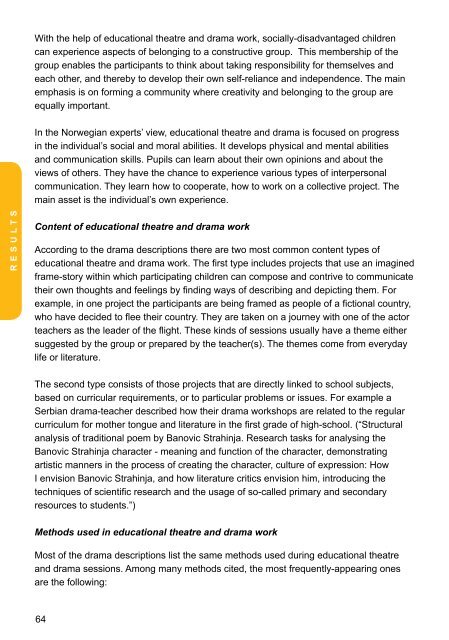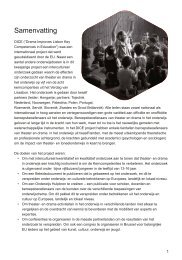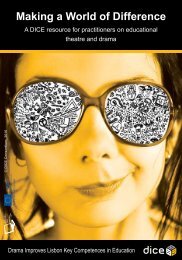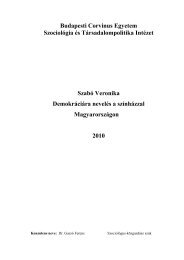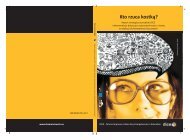Policy Paper - Drama Improves Lisbon Key Competences in Education
Policy Paper - Drama Improves Lisbon Key Competences in Education
Policy Paper - Drama Improves Lisbon Key Competences in Education
You also want an ePaper? Increase the reach of your titles
YUMPU automatically turns print PDFs into web optimized ePapers that Google loves.
With the help of educational theatre and drama work, socially-disadvantaged children<br />
can experience aspects of belong<strong>in</strong>g to a constructive group. This membership of the<br />
group enables the participants to th<strong>in</strong>k about tak<strong>in</strong>g responsibility for themselves and<br />
each other, and thereby to develop their own self-reliance and <strong>in</strong>dependence. The ma<strong>in</strong><br />
emphasis is on form<strong>in</strong>g a community where creativity and belong<strong>in</strong>g to the group are<br />
equally important.<br />
In the Norwegian experts’ view, educational theatre and drama is focused on progress<br />
<strong>in</strong> the <strong>in</strong>dividual’s social and moral abilities. It develops physical and mental abilities<br />
and communication skills. Pupils can learn about their own op<strong>in</strong>ions and about the<br />
views of others. They have the chance to experience various types of <strong>in</strong>terpersonal<br />
communication. They learn how to cooperate, how to work on a collective project. The<br />
ma<strong>in</strong> asset is the <strong>in</strong>dividual’s own experience.<br />
• dialogues - as the simplest way of be<strong>in</strong>g <strong>in</strong> a role, tak<strong>in</strong>g a perspective which<br />
engages all the students, develops imag<strong>in</strong>ation, critical th<strong>in</strong>k<strong>in</strong>g and empathy;<br />
• <strong>in</strong>terviews - conversations with specific characters <strong>in</strong> the form of fictional media<br />
coverage, press conferences or op<strong>in</strong>ion polls;<br />
• letters - as narratives from a perspective (on behalf) of a character and as a reaction<br />
to a specific event or a dramatic situation;<br />
• improvisations - enactions of possible solutions to spontaneously discussed openended<br />
problems which are formulated <strong>in</strong> such a way as to stimulate curiosity or<br />
suspense;<br />
• ‘sculptures’ - a frozen form of self-, pair- or team-created expression of emotional<br />
state or attitude, and as a reaction to a specific event or situation. The ‘sculptures’<br />
can be made through shap<strong>in</strong>g by touch, demonstration (mirror<strong>in</strong>g) or giv<strong>in</strong>g verbal<br />
<strong>in</strong>structions.<br />
R e s u l t s<br />
Content of educational theatre and drama work<br />
Accord<strong>in</strong>g to the drama descriptions there are two most common content types of<br />
educational theatre and drama work. The first type <strong>in</strong>cludes projects that use an imag<strong>in</strong>ed<br />
frame-story with<strong>in</strong> which participat<strong>in</strong>g children can compose and contrive to communicate<br />
their own thoughts and feel<strong>in</strong>gs by f<strong>in</strong>d<strong>in</strong>g ways of describ<strong>in</strong>g and depict<strong>in</strong>g them. For<br />
example, <strong>in</strong> one project the participants are be<strong>in</strong>g framed as people of a fictional country,<br />
who have decided to flee their country. They are taken on a journey with one of the actor<br />
teachers as the leader of the flight. These k<strong>in</strong>ds of sessions usually have a theme either<br />
suggested by the group or prepared by the teacher(s). The themes come from everyday<br />
life or literature.<br />
The second type consists of those projects that are directly l<strong>in</strong>ked to school subjects,<br />
based on curricular requirements, or to particular problems or issues. For example a<br />
Serbian drama-teacher described how their drama workshops are related to the regular<br />
curriculum for mother tongue and literature <strong>in</strong> the first grade of high-school. (“Structural<br />
analysis of traditional poem by Banovic Strah<strong>in</strong>ja. Research tasks for analys<strong>in</strong>g the<br />
Banovic Strah<strong>in</strong>ja character - mean<strong>in</strong>g and function of the character, demonstrat<strong>in</strong>g<br />
artistic manners <strong>in</strong> the process of creat<strong>in</strong>g the character, culture of expression: How<br />
I envision Banovic Strah<strong>in</strong>ja, and how literature critics envision him, <strong>in</strong>troduc<strong>in</strong>g the<br />
techniques of scientific research and the usage of so-called primary and secondary<br />
resources to students.”)<br />
Methods used <strong>in</strong> educational theatre and drama work<br />
Most of the drama descriptions list the same methods used dur<strong>in</strong>g educational theatre<br />
and drama sessions. Among many methods cited, the most frequently-appear<strong>in</strong>g ones<br />
are the follow<strong>in</strong>g:<br />
A Polish example of a drama workshop illustrates the use of a wide range of pedagogicalmethodological<br />
tools. A typical session starts with warm up exercises and concentration<br />
games; they <strong>in</strong>volve simple movement patterns (stretch<strong>in</strong>g, mirror<strong>in</strong>g, pantomime<br />
or dance), breath<strong>in</strong>g, humm<strong>in</strong>g or s<strong>in</strong>g<strong>in</strong>g, speed or reaction games, bra<strong>in</strong>storm<strong>in</strong>g,<br />
improvis<strong>in</strong>g with props, emotions or simple situations. Students work <strong>in</strong>dividually, then <strong>in</strong><br />
pairs, or <strong>in</strong> small or large groups. The reflection part of the workshop has the form of a<br />
structured discussion or uses symbolic techniques of drama like a tunnel of thoughts, role<br />
on the wall, freeze-frame with bubbles.<br />
There are only a few drama descriptions report<strong>in</strong>g on the usage of more traditional forms<br />
of teach<strong>in</strong>g and learn<strong>in</strong>g. For example a Slovenian one: “We start with read<strong>in</strong>g exercises<br />
around a table. The actors here participate <strong>in</strong> reader's school and the dramaturgical<br />
analysis of the play. When they are confident <strong>in</strong> pronunciation and word emphasis, and<br />
are clear with the melody of the sentences, we move on to the stage itself. At this po<strong>in</strong>t<br />
the notion of teamwork is important because it’s needed to manage the actions and<br />
movement of the production.”<br />
Evaluation of children<br />
There are only three comments on evaluation of<br />
children’s performance <strong>in</strong> the drama descriptions.<br />
The Palest<strong>in</strong>ian practice of evaluation shows that<br />
<strong>in</strong>dividual <strong>in</strong>vestment by the children is stimulated<br />
and praised. In the daily evaluations, the teacher<br />
collects feedback from the children to check the<br />
ownership process and stimulate their <strong>in</strong>dividual<br />
<strong>in</strong>vestment. Teachers offer more comments on<br />
the style and sometimes the scenes are worked<br />
on and presented aga<strong>in</strong> for further feedback.<br />
R e s u l t s<br />
64<br />
65


